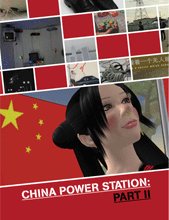China Power Station Part II
dal 7/9/2007 al 1/12/2007
Segnalato da
Astrup Fearnley Museum of Modern Art
Cao Fei
Chen Qiulin
Chu Yun
Duan Jianyu
Hu Xiangqian
Ji Weiyu
Kan Xuan
Liang Yue
Liu Chuang
Liu Ding
Liu Wei
Liu Weijian
Lu Chunsheng
Ou Ning
Pak Sheung Chuen
Qiu Anxiong
Song Tao
Sun Xun
Xu Zhen
Xue Tao
Yang Fudong
Zhang Ding
Zhou Tao
Zhou Zixi
Gunnar B. Kvaran
Hans Ulrich Obrist
Julia Peyton-Jones
7/9/2007
China Power Station Part II
Astrup Fearnley Museum, Oslo
The exhibition includes some of today's most significant young artists from China.Not only are these the first "post-Mao children", but they are also a mobile generation of artists connected across the globe.

Young artists from China
The curators are Gunnar B. Kvaran (Astrup Fearnley Museum of Modern Art), Hans
Ulrich Obrist (Serpentine Gallery) and Julia Peyton-Jones (Serpentine Gallery).
The exhibition 'China Power Station: Part II' includes some of today's most
significant young artists from China. Astrup Fearnley Museum of Modern Art in
collaboration with Serpentine Gallery in London initiated this evolving project, of
which the first part was shown at Battersea Power Station in London last autumn.
The artists presented in the exhibition in Oslo are Cao Fei, Chen Qiulin, Chu Yun,
Duan Jianyu, Hu Xiangqian, Ji Weiyu, Kan Xuan, Liang Yue, Liu Chuang, Liu Ding, Liu
Wei, Liu Weijian, Lu Chunsheng, Ou Ning, Pak Sheung Chuen, Qiu Anxiong, Song Tao,
Sun Xun, Xu Zhen, Xue Tao, Yang Fudong, Zhang Ding, Zhou Tao and Zhou Zixi.
In an event-driven culture, sustainability and legacy are at the core of what an art
institution should be. For this precise reason, China Power Station was conceived
from the outset as an evolutive form, a multivalent project that shifts according to
contexts in its host locales. London never had Chinese contemporary art exhibition
of critical mass before China Power Staion: Part I premiered in the UK last Autumn.
Oslo, on the other hand, has had a comparatively denser history of exhibitions on
art and culture in China, so the current version is more the result of fine-tuning.
This is evident in the decision to focus on a younger generation of artists to
emerge post-2000.
During the 1980s there was an explosion of creativity in China which produced a
pioneering generation of artists including Ai Weiwei, Huang Yong Ping and Chen Zhen.
These figures came out of an elongated period of cultural isolation and operated in
a closed regional context characterised by a highly traditional way of conceiving
and appreciating art. They were also the product of a very particular
socio-political situation, not unlike that of the USA and Europe during the 1960s.
In the wake of the Tiananmen Square riots, a different kind of cultural revolution
was brewing and a true awareness of the avant-garde had arrived.
More recently, we witnessed the emergence of a generation of artists born in late
1970s and throughout the 1980s who have come of age in this era of avant-garde
identity. In general, they are well educated, versed in the lessons of both Western
and Eastern art history and benefit from the freedom to travel, which have enabled
them to build extensive international relationships. Not only are these the first
'post-Mao children', but they are also a mobile generation of artists connected
across the globe.
Despite their mobility and the tendency of their predecessors to go into exile
overseas, this younger group chose to stay in China. One reason for this may be
because of the sometimes advantageous working conditions and beneficial economic
situations that can arise and which are helpful in the production of their work.
Additionally, China is a sign of a power, resilience and dynamism in the new
millennium: it has shifted globally from the cultural periphery to the centre, and
the artists wants to stay in the country of their birth because they are intrigued
by their homeland and are eager to be a part of its future development.
Though Western artists still have innumerable issues with which to engage, and to
even contest, these concerns are arguably heightened in China. In other words,
Chinese artists are implicated in a habitual struggle not only to produce work but
to negotiate the challenging reality of the social, economic and political landscape
in which they live. One goal of China Power Station: Part II, therefore, is to shed
light on these struggles and to uncover some of the most innovative responses that
are currently being generated in relation to this territory that provides such a
rich terrain for artistic exploration.
As an exhibition, China Power Station must also be seen against the backdrop of the
extraordinary development of museums and galleries in China in recent years. Indeed,
collections are presently being built at speed, and culture is being written as it
takes place. Yet China Power Station: Part II is not merely a knee-jerk reaction to
this state of affairs, but rather a considered response. Above all, it is the
curators intentions that China Power Station serves to complement the programmes of
these burgeoning institutions in China, and to open more dynamic ways of thinking
about this new generation of Chinese artwork, exhibited by the Serpentine Gallery,
London -- autumn 2006 (Part I), at the Astrup Fearnley Museum, Oslo -- 8.9-2.12.07
(Part II), at MUDAM: Musée d'Art Moderne Grand-Duc Jean, Luxembourg -- spring
2008 (Part III), and finally brought back to China and shown in Beijing -- autumn
2008 (Part IV).
China Power Station, Part I and II is initiated by Astrup Fearnley Museum of Modern
Art and Serpentine Gallery and supported by The Red Mansion Foundation.
The Astrup Fearnley Museum of Modern Art is generously supported by the Thomas
Fearnley, Heddy and Nils Astrup Foundation, and Astrup Fearnley AS
Opening: 8 September 2007
Astrup Fearnley Museum of Modern Art
Dronningens gt 4, 0107 Oslo, Norway
Free Admission



